
Key Takeaways
- The federal government has increasingly shaped public education through funding to support higher-cost students.
- Tennessee typically receives about $1.1 billion annually in federal K-12 funding for over a dozen programs that have grant-specific and broader federal requirements.
- In recent years, Tennessee’s actions or preferences related to K-12 education have at times conflicted with current or proposed federal policy for testing and gender-related policies.
- Some trade-offs and considerations for federal dollars, the requirements attached to those funds, and what would happen if Tennessee rejected those dollars include:
- No state has ever rejected federal K-12 dollars, so much is unknown.
- Many of the requirements attached to federal dollars align with state policymakers’ goals and/or are integrated into the state’s own requirements.
- Federal requirements provide assurances and an extra layer of accountability important to many children and their families.
- Tennessee has to adapt when federal requirements change.
- The federal government hasn’t always fully funded its commitments.
- If Tennessee rejected federal dollars, the state would have to work out many details to ensure a smooth transition for districts.
- The days of historically large surpluses may be over, but Tennessee likely still has room in the budget to replace federal funding at the expense of other potential investments.
- If rejected, much of Tennessee’s federal education funding would probably go to other states.
- Federal requirements create administrative burdens that may or may not still exist if Tennessee rejected federal dollars.
- Many federal requirements could still apply to Tennessee schools even if the state rejected federal K-12 dollars — creating questions that would likely be resolved in court.
- It is unclear if Tennessee would still get federal education aid to weather recessions and how quickly the state could reverse course if policymakers changed their minds.
State policymakers are exploring the implications of federal K-12 funding — what it requires of the state and whether to reject some or all those dollars. This report reviews the federal government’s role in K-12 education, key federal programs and requirements, recent tensions between Tennessee and federal requirements, and some trade-offs and considerations involved. A prior report presents key findings from our analysis of federal funding data for each of Tennessee’s 142 local education agencies.
Background
State and local governments bear most of the legal and financial responsibility for K-12 education. All 50 state constitutions mandate public education, and in FY 2019 (before the pandemic) about 92% of all dollars for American public K-12 schools came from state and local revenues. (1) (2)
The federal government has increasingly shaped public education over the last century through funding to support higher-cost students. Although the U.S. Constitution is silent on education, federal influence in K-12 has grown since roughly the mid-20th century — largely a result of President Lyndon Johnson’s war on poverty and the civil rights movement. The Elementary and Secondary Education Act (ESEA) of 1965 — the basis for today’s Every Student Succeeds Act (ESSA) — established supplemental funding to support low-income students. These funds came with new requirements and served as the basis for more aggressive federal enforcement of anti-discrimination efforts like school desegregation. (3) (4) (5) (6) (7) ESEA/ESSA dollars, along with school nutrition funds, remain the primary basis for the federal government’s role in K-12 policy.
The federal government has broad authority to both spend federal dollars and attach far-reaching requirements for recipients of those funds. In the modern era, the federal government’s power to spend taxpayer money is expansive — including on things like education not explicitly mentioned in the Constitution. The U.S. Supreme Court has found that the federal government can also place conditions on those dollars in ways that can influence policy beyond the specific purpose of the award itself. (8)
Limits on how much the federal government can require can change. How far federal funding requirements can go and who at the federal level can set them are fundamental constitutional issues often challenged and continually refined by the courts. For example, in 2012, the Supreme Court found that the Affordable Care Act’s requirement that states expand Medicaid eligibility or risk losing all federal Medicaid dollars went too far. As a result, what Congress intended to be a mandate for states instead became optional. (8)
Key Federal K-12 Programs and Requirements
Tennessee typically receives about $1.1 billion annually[1] in federal K-12 funding for over a dozen programs that have grant-specific and broader federal requirements (Figure 2). These dollars made up about 11% of revenues for Tennessee’s schools for the 2018-2019 school year — more than all but 13 states (Figure 3). (2) This section provides key information about the three largest programs — child nutrition, ESSA Title I, and the Individuals with Disabilities Act (IDEA) — and broader requirements that affect state and local K-12 operations. These three programs comprise nearly 90% of the federal K-12 dollars allocated to the state (Figure 2) and over 88% of those awarded to school districts. (9) (10) (11) (12) (13) (14) (15) (16) (17) Child nutrition is the largest program and administered by the U.S. Department of Agriculture (USDA). The U.S. Department of Education (ED) administers ESSA Title I and IDEA.
Appendix Table 1 provides more information on each federally funded grant.
Figure 1
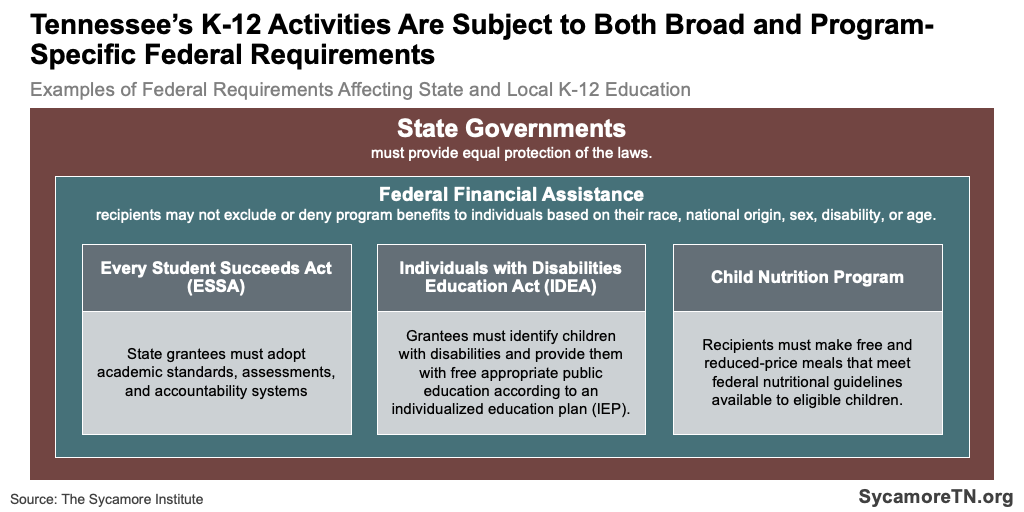
Figure 2
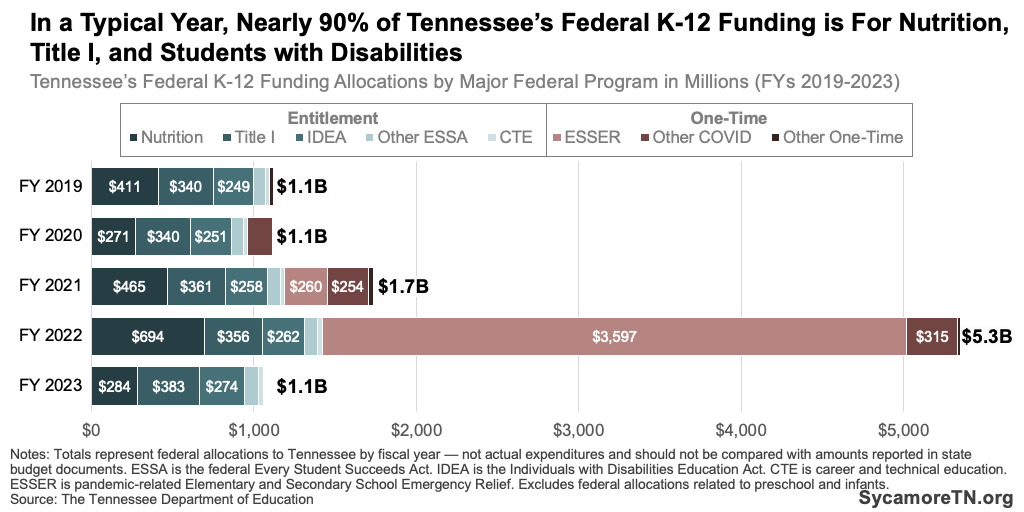
Figure 3
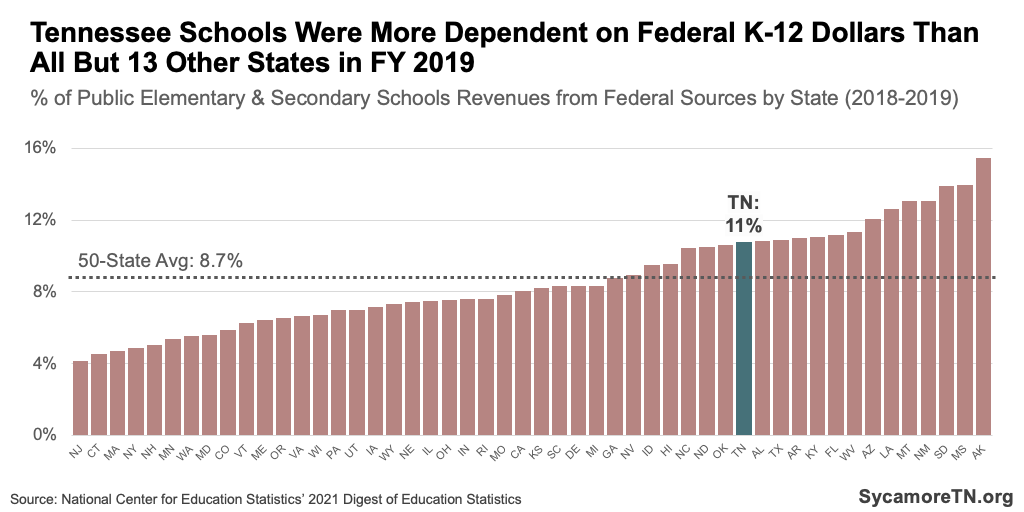
School Nutrition
School nutrition is Tennessee’s single largest source of federal funding for K-12 activities. Before the pandemic, the state and local school districts received over $400 million in USDA funding for school nutrition programs.
What’s It For?
Federal child nutrition programs subsidize the cost of providing meals and nutritious snacks to students. (18) These activities include several programs — the National School Lunch Program, the School Breakfast Program, the Summer Food Service Program, the Fresh Fruits and Vegetables Program, and related administrative costs.
- National School Lunch Program (NSLP) — NSLP offsets the cost of providing in-school lunches, including low- and no-cost lunches for students from low-income families.(19) In FY 2019, the program subsidized 105 million lunches for just over 641,000 students in Tennessee. (20) (21)
- School Breakfast Program (SBP) — SBP largely mirrors NSLP in providing school breakfasts. (19) In FY 2019, the program subsidized 63 million breakfasts for about 382,000 Tennessee students.(22) (23)
- Summer Food Service Program (SFSP) — SFSP offsets the cost of providing meals and snacks to students in low-income areas when school is out of session, often at schools or off-site (e.g., community centers, camps).(19) In FY 2019, the program subsidized over 3 million summer meals for about 61,000 students statewide. (24) (25)
- Fresh Fruit and Vegetable Program (FFVP) — FFVP funds schools to provide fresh produce as snacks outside of normal breakfast and lunch service. (19)
How Is Funding Distributed?
Local school districts are reimbursed by the federal government (through states) for each eligible meal or snack they serve. Reimbursement rates are laid out in federal law, updated annually for inflation, and based on child eligibility for free or reduced-priced meals. (18) For example, in the 2023-2024 school year, full-price lunches are reimbursed at up to $0.56 per meal, reduced-price at up to $4.10, and free at up to $4.50 — depending on a district’s concentration of eligible students and adherence to federal nutrition standards. (26) Grants are also available to cover state administrative costs and necessary equipment.
What’s Required?
Federal rules dictate everything from how schools must determine eligibility to what foods can be served to students. Examples of requirements include:
- Eligibility — According to federal requirements, students can qualify for free or reduced-price meals if they are eligible for and receive other public benefits (e.g., SNAP, TANF) — known as direct certification. States can also determine eligibility by having families fill out an application. (18) The federal government updates eligibility guidelines annually and provides extensive guidance on how state officials and local school districts must make and verify these determinations.(27) (28)
- Meal Pricing — Under federal law, direct certification students and those in families with incomes under 130% of the federal poverty level (FPL) are entitled to free meals, and children in families between 130-185% of FPL are entitled to reduced price meals (defined as lunch for $0.40 or less).(18) Federal law and policy also dictate how districts must set the price of meals for students who pay full price. (29) (30)
- Nutritional Standards – To be eligible for reimbursement, schools must serve meals that meet federal nutritional standards to ensure children have nutritious and well-balanced meals. For example, daily lunches for grades K-5 must include a minimum of 0.5 cup of fruit, 0.75 cup of vegetables, an ounce each of grains and meat, and one cup of low-fat or no-fat milk. These standards also include parameters for calorie counts, types of vegetables, whole grains, and fat and sodium content.(31)
- Controls — States and school districts must follow specific protocols to ensure compliance with federal rules. These include checking the accuracy of meal counts, verifying a sample of eligibility applications, and conducting nutrient analyses on meals. (32)(33) (31)
- Additional Requirements — As a condition of receiving meal reimbursements, the federal government also requires that all foods in schools meet certain nutritional standards — including foods not subsidized by federal funding. In other words, most snacks offered at schools outside of school meals must comply with calorie, sugar, sodium, and fat limits set in federal regulation.(18)
Every Student Succeeds Act – Title I
Before the pandemic, Tennessee received about $340 million under ESSA’s Title I provisions, primarily targeting low-income students.
What’s It For?
Title I funds are designed to supplement funding for students from low-income families to close achievement gaps. Depending on a school’s concentration of students in poverty, funds can either be used for targeted assistance for low-income students or activities that benefit all students. Examples of activities include increasing family engagement, upgrading instructional materials, coordinating social services, providing tutoring, and addressing school safety issues. Funds are also used at the state and local levels to administer the program, support assessments, carry out school improvement activities associated with a state’s accountability system, and serve special populations (e.g., youth who are migrants, neglected, or delinquent). (34) (35)
How Is Funding Distributed?
Title I funding is distributed to states largely based on the number and concentration of low-income, school-age children in each state’s school districts. Four different Title I grants each have a unique formula that primarily considers every state’s formula child count (i.e., the number of children ages 5-17 in each school district in families below the poverty level) and its “expenditure factor” (i.e., their average state and local per pupil expenditures for public K-12 education). Final state allocations are then determined based on available annual funding for Title I and adjustments within each formula that account for “hold harmless” requirements (i.e., minimizing annual funding reductions for locals), minimum allocations for small states, and districts with higher concentrations of child poverty. (36) (37) (38)
States must use these same counts above to distribute their Title I dollars to local districts, and districts award funds to schools based on each school’s concentration of students in poverty. States and districts can hold some Title I funds for administration and school improvement activities. To receive funds, districts and schools must also have formal plans for how they intend to spend Title I funds, coordinate those efforts with other federal programs, and boost student achievement. (35) (34)
Tennessee receives less Title I funding per low-income child than most other states. In FY 2019, Tennessee’s Title I allocation amounted to about $306 per pupil — on par with the national average. (10) (39) However, this amounted to about $1,500 per child ages 5-17 in poverty — less than all but nine other states (Figure 4). (10) (40) (39)
Figure 4
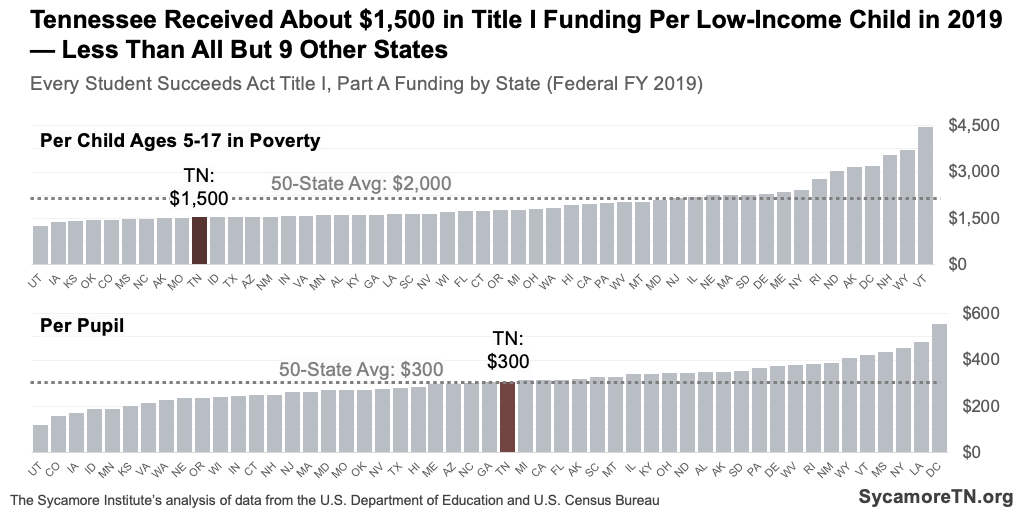
What’s Required?
To receive Title I funds, each state must establish its own statewide continuum of academic standards, assessments, accountability measures, and targeted school support. States document compliance with these standards in a consolidated state plan that addresses strategies associated with other federal ED funding (i.e., other ESSA parts, IDEA, and CTE). (41)
- Standards — Every state must establish “challenging academic standards.” ESSA bars the federal government from mandating any specific standards or curriculum. (41)(42) (43)
- Assessments — Each state must administer annual tests aligning with their academic standards and measuring proficiency and growth. There are specific parameters for what subjects students must be tested on and when (discussed later), but ESSA prohibits the federal government from prescribing any specific test or test items. (41) (44) (42)(43)
- Accountability — Each state must issue an annual report card and establish an accountability system to measure and “meaningfully differentiate” each school’s performance. The system must also include a method for identifying at least three categories of schools needing additional support to improve performance. (41)
- School Support — States must use their accountability systems to identify schools needing support to improve. (41)
- Fiscal Requirements — To receive Title I funds, the state, local school districts, and schools must meet several spending requirements. Maintenance of effort, “supplement, not supplant,” and comparability of services provisions ensure federal funds add to rather than replace state and local dollars at Title I schools. To check compliance, the federal government requires documentation and written assurances.(45) (46)
- Reporting — Many of the requirements associated with Title I relate to reporting. To fulfill the requirements above, states must report extensively on how they’re carrying out the specified activities. For example, the consolidated plan discussed above must describe how the state intends to meet the standards, assessment, accountability, and support requirements. Each year, states must also submit reports to ED that assure compliance with federal rules, provide links to things like state report cards, and report data on items like the use of funds and the number of districts carrying out certain activities.(47)
Individuals with Disabilities Education Act (IDEA)
Before the pandemic, Tennessee received almost $250 million for K-12 under the Individuals with Disabilities Education Act (IDEA).
What’s It For?
IDEA funding offsets the additional costs of providing an appropriate education to students with disabilities. In the 1970s, officials nationwide increasingly recognized that students with disabilities were not receiving the services and resources they needed to benefit from public schooling. State disability education laws and court decisions began to address that gap, but states often did not have the resources to fulfill their new responsibilities. Through the IDEA’s predecessor law, the federal government bolstered existing laws and funding for educating children with disabilities. (48)
How Is Funding Distributed?
States receive funding based on each’s current share of the population ages 3-21, those in that age range in low-income families, and a legacy count of students with disabilities. When available federal funding for IDEA is the same or more than in the prior year, each state gets what it received in FY 1999, based on each state’s number of eligible students with disabilities in 1999. Then, 85% of the remaining funds are distributed based on each state’s share of individuals ages 3-21 and the other 15% on current counts of those 3-21 in poverty. States’ allocations are then distributed to local school districts in the same way. (49)
Tennessee receives more per child served than most other states. Our state serves about 120,000 kids ages 3-21 each year under the IDEA. (50) In FY 2019, Tennessee’s allocation amounted to about $1,900 for each of these children served — the 11th highest amount in the country (Figure 5). (10) (50)
Figure 5
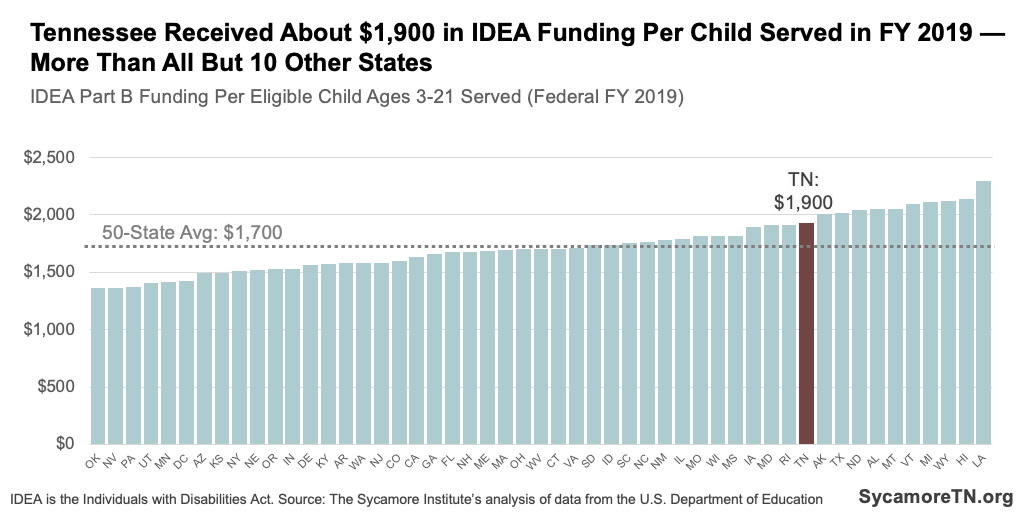
What’s Required?
To receive IDEA funds, states must follow specific rules in identifying and evaluating students with eligible disabilities for specialized educational services. Examples include:
- Free Appropriate Public Education — The IDEA requires that schools provide eligible children with individualized services at no cost, also known as a “free appropriate public education” or FAPE. To fulfill this requirement, schools must identify eligible children and create an individualized education plan (IEP) to determine each child’s needs.(51)Over time, the legal parameters for providing a FAPE have been revisited and refined by the U.S. Supreme Court (SCOTUS) and lower courts. For example, SCOTUS decisions have concluded that a FAPE must include enough services for a child to get educational benefits and make progress but doesn’t necessarily have to maximize an eligible child’s potential. (52) (53)
- Eligibility — The IDEA is specific about which children are eligible for the rights and guarantees the law affords. They must both 1) have a disability in at least one of 13 specific categories and 2) require special education and other services to benefit from schooling.(54)
- Individualized Education Plans — IEPs serve as the vehicle for identifying each eligible student’s needs. Federal law and regulation lay out very specific requirements for how to formulate an IEP, who must be involved, and what it must include.(49) (51) (55)
- Least Restrictive Environment — The IDEA also requires states to make every effort to educate children with disabilities alongside those without (i.e., in the least restrictive environment possible). To fulfill this requirement, school districts must provide a continuum of educational settings and support services to ensure eligible children receive a FAPE in the least restrictive environment for their needs.(49) (51)
- Complaint Processes — The IDEA lays out processes to ensure that eligible students can exercise their right to a FAPE. States and local school districts must follow detailed procedures when a child’s family files a complaint. Depending on the nature of the complaint, districts must also provide for an independent evaluation of a child, engage in mediation, and provide due process hearings.(49) (56)
- Fiscal Requirements — Similar to Title I, the state, local school districts, and schools must meet maintenance of effort and “supplement, not supplant” requirements to receive IDEA funding.(49)
Federal Financial Assistance
Several broader requirements also apply to the receipt of any federal education dollars. Many of these types of broad requirements are often said to apply to “federal financial assistance” (FFA). (57) (58)
- Title VI of the Civil Rights Act of 1964 bars discrimination based on actual or perceived race, color, or national origin. This means that any activity funded by the federal government cannot discriminate against, exclude, or deny program benefits based on these characteristics. In the education setting, this applies to everything from discipline and grading to athletics and class assignment. It also extends to providing language services to students and parents who don’t speak English. (59)(60) (61) (62)
- Title IX of the Education Amendments of 1972 prohibits discrimination based on sex in education programs and activities that receive FFA. Like Title VI requirements, it extends to all aspects of the K-12 experience. (61)(63) (64)
- Section 504 of the Rehabilitation Act of 1973 bars discrimination against individuals with a disability. In the educational setting, for example, it requires recipients of FFA to meet the needs of students with disabilities to the same extent as the needs of other students. (61) (65)(66) (67)
- Title II of the Americans with Disabilities Act (ADA) prohibits state and local governments from discriminating based on disability. In schools, for example, it bars state and local governments from segregating or denying services to students with disabilities. There are numerous nuanced ways in which both Section 504 and the ADA provide protections to students with disabilities in addition to and/or outside of IDEA requirements.(65) (67)
- The Age Discrimination Act of 1975 prohibits discrimination based on age in programs receiving FFA.(61)
- The Equal Educational Opportunities Act of 1974 requires that school districts help non-English-speaking students participate equally in education programs.(68)
- The Family Educational Rights and Privacy Act (FERPA) creates privacy safeguards for student records for any entity receiving federal education dollars. The law and its associated regulations and guidance lay out who has access to education records, under what conditions, and the procedures that must be followed.(69)
- The Boy Scouts of America Equal Access Act requires that any entity receiving FFA through ED allow specific organizations the same access to public school facilities as other activities. These include Boy and Girl Scouts, Boys and Girls Clubs, Big Brothers Big Sisters, Future Farmers of America, and other federally-defined “patriotic and national organizations.” (70) (71)
Constitutional Requirements
With or without federal funding, the U.S. Constitution can sometimes require things of state and local governments that affect how they manage K-12 education. One of the more significant is the U.S. Constitution’s 14th Amendment, which bars states from denying anyone equal protection of the laws. This served as the early basis for legal rulings barring school segregation and other racial discrimination in school settings (i.e., Brown v. Board of Education). The 14th Amendment continues to serve as a basis for refining school responsibilities for students and families from protected classes (i.e., disability, national origin, race, religion, and sex). See the following citations for examples: (72) (73) (74) (75).
How Federal Requirements Are Decided
Federal requirements can evolve via every available policy tool across all three branches of the federal government — from the law to the courts to administrative guidance. These requirements are spelled out in the Constitution or federal law or the product of executive and/or judicial interpretations of constitutional and statutory provisions. Federal agencies often determine how broad FFA requirements apply to specific program funding areas. (57) Together, this means that requirements affecting K-12 education often change over time based on actions and interpretations across all three federal branches. For example, one presidential administration may interpret the meaning and reach of anti-discrimination requirements differently than another and issue regulations and/or sub-regulatory guidance (e.g., policy memos, program performance reviews) accordingly.
Recent Tennessee Tensions with Federal Requirements
In recent years, Tennessee’s actions or preferences related to K-12 education have at times conflicted with current or proposed federal policy. This section highlights the two most significant.
Title I Assessments
Although ESSA does not require specific tests or test content, it does lay out a precise regime for what subjects must be tested and when (Figure 6). For example, all 3rd- 8th graders must be tested each year in reading and math, and high schoolers must be tested at least once in those subjects before graduating. All students of the same grade level must also take the same test to allow for school comparisons — with some accommodations and/or exceptions for students with cognitive disabilities and English language learners. (76)
Figure 6
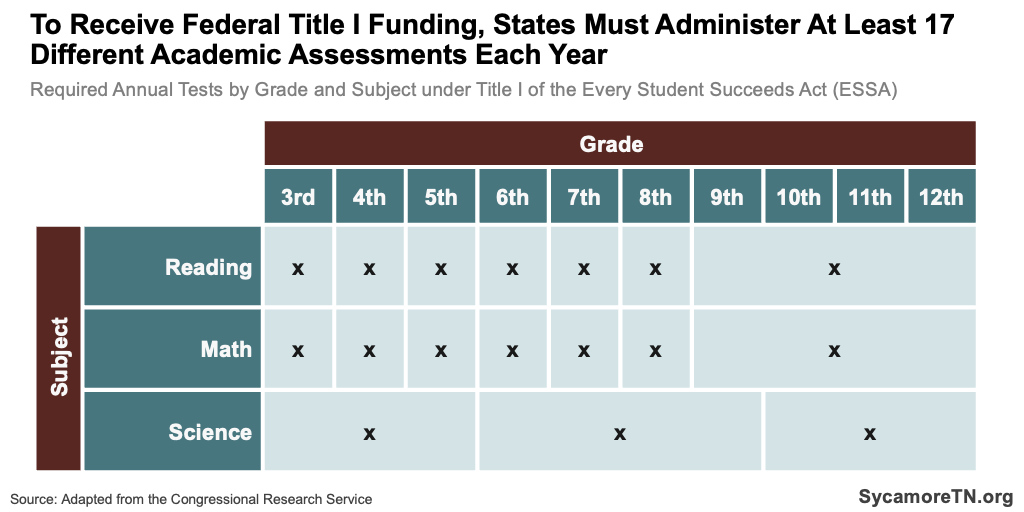
Tennessee has struggled to meet some of these assessment requirements but has proposed changes to bring the state into compliance. For example, Tennessee’s academic standards allow for two different series of high school courses for math and English (e.g., Integrated Math I, II, and III or Algebra I and II and Geometry) and tailor its annual assessments to these different paths. In 2021, ED concluded that this approach violates ESSA’s requirement that all students in the same grade take the same tests and conditioned the state’s continued receipt of Title I dollars on correcting the issue. (77) (78) The state proposed an approach to address ED’s concerns without making substantive changes to the assessments, but it was rejected in June 2023. (79) This was one of several compliance issues ED raised in its 2021 review — all of which the state is working to address with proposed changes to its federal plan. (80) (81)
Title IX and Gender Identity
Over the last two years, the Biden administration has proposed new rules under Title IX regarding transgender students. Following a 2021 executive order by President Biden, both ED and USDA have proposed changes to Title IX requirements that would affect states’ eligibility for both agencies’ K-12 funding — including explicitly extending the law’s protections to gender identity and sexual orientation. (82) (83) (84) (85) (86) Together, these changes would, for example, prohibit schools from banning participation in sports based on gender identity alone or requiring sex-specific bathrooms. To date, these proposed changes have not taken effect. (87)
During this same time, Tennessee sued the Biden administration over both proposals and passed new laws at odds with the proposed federal requirements:
- Legal Challenges — Tennessee was one of 20 states to challenge an ED proposal and one of 22 to sue over the USDA proposal.(88) (89) In these cases and other statements of opposition, the state charges that the Biden administration’s expanded interpretation is executive overreach. (90) (91) (92) (93) (94) (95) (96) (97) (98)
- New State Laws — Meanwhile, under new state laws passed in 2021 and 2022, local school districts must determine school sports eligibility based on students’ sex at birth or risk losing state K-12 funding.(99) (100) (101) At the time they were considered, the legislature’s Fiscal Review staff did not expect those laws to affect federal funding. (102) (103) However, the cost estimate for a more recent 2023 change defining “sex” throughout Tennessee law as that recorded at birth noted that it could possibly jeopardize federal funding across state government — including all of the Tennessee Department of Education’s (TDOE) federal funds. (104) (105)
The Future of Federal K-12 Funding: Considerations and Trade-Offs
This section identifies — in no particular order — 11 potential trade-offs and considerations associated with federal dollars, the requirements attached to those funds, and/or what would happen if Tennessee rejected those dollars.
1. No state has ever rejected federal K-12 dollars, so much is unknown.
There are more questions than definitive answers about what rejecting federal K-12 dollars could mean for Tennessee’s obligations because no state has ever done so. Policymakers in at least two other states — Oklahoma and South Carolina — have reportedly broached the idea recently. However, neither has taken any formal action, so there’s no precedent on which to make predictions about what issues and challenges our state could face.
2. Many of the requirements attached to federal dollars align with state policymakers’ goals and/or are integrated into the state’s own requirements.
Tennessee’s goals have often aligned with federal goals, and many state laws and regulations are comparable to or adapted from federal ones. For example, Tennessee began administering state assessments in 1988 — before federal testing requirements existed. (106) (107) Meanwhile, state law and regulation:
- Requires an accountability and school grading system akin to the accountability system required by Title I.(108) (109)
- Adopts the federal nutrition program regulations by reference and conditions any state money for nutrition on meeting national nutritional standards and program eligibility requirements.(110) (111)
- Creates an Office for Civil Rights within TDOE to adjudicate and enforce federal civil rights complaints and requirements.(112)
- Adopts much of IDEA and its regulations by reference.(113) (114)
3. Federal requirements provide assurances and an extra layer of accountability important to many children and their families.
Federal laws guarantee certain rights to the populations discussed earlier and lay out formal processes for adjudicating complaints. These processes detail who can file complaints, when, where, and the steps to follow as the complaint is investigated and resolved. (115) (116) (57)
Federal requirements also guarantee an additional layer of oversight beyond the state’s processes. Complaints can be filed locally or with the Offices of Civil Rights (OCR) in either TDOE or ED, and in most cases, claims can also be filed in federal court. (115) (116) (57) Since 2012, for example, ED’s OCR helped resolve at least 95 cases involving 47 Tennessee school districts. Over 90% of the cases were related to disability discrimination and accommodations involving things like facility accessibility issues, allegations of harassment, and failing to fulfill a student’s IEP. (117) Another 152 cases were under investigation as of October 2023. (118)
Some requirements first arose in response to discriminatory and exclusionary state practices, leading some stakeholders to fear what may happen if they no longer apply. (119) As discussed earlier, many of these laws came out of the civil rights movement at a time of rampant racial discrimination and school segregation. Meanwhile, the IDEA was largely established because children with disabilities often were learning in isolated settings, not receiving any special education services, or — in some cases — excluded from public schools altogether. (48) Students and families in these protected classes may worry that such practices could return in the absence of federal oversight. (120)
Tennessee has rules and complaint processes that could continue, but it has not been made clear that they will. Public statements and press releases have generally focused on the burden of federal mandates and restrictions with little if any reference to what rules and protections state policymakers might want to preserve. (121) (122)
4. Tennessee has to adapt when federal requirements change.
ESSA — passed in December of 2015 — included substantive changes from the law it replaced, the No Child Left Behind (NCLB) Act. ESSA is widely regarded as being less prescriptive than NCLB — eliminating many of the old law’s specific requirements and providing states with new flexibilities. It also includes provisions like identifying schools that need targeted assistance, engaging stakeholders in planning, limiting the number of students taking alternative tests, and expanding the number of school accountability measures. (123) (124)
When the federal government pivots like this, Tennessee must as well. In this case, that meant deciding how to act on both new flexibilities and new requirements. For example, Tennessee had finalized its prior strategic plan for K-12 education in October of 2015, just weeks before ESSA was passed. As a result, the state revisited some of its policies to use the new flexibilities and comply with the new mandates — including for assessments, accountability, and school support. (125)
5. The federal government hasn’t always fully funded its commitments.
Some federal K-12 dollars are specifically meant to offset the additional costs of meeting federal requirements, but funding levels haven’t always lived up to promises. For example, the IDEA authorizes federal funding to cover up to 40% of the excess costs associated with providing students with disabilities the services guaranteed in the law. However, the IDEA has never been funded at this amount. As of FY 2019, actual federal IDEA funding represented only about 14% of the estimated excess cost. (48) (126)
6. If Tennessee rejected federal dollars, the state would have to work out many details to ensure a smooth transition for districts.
Federal money and guidelines are woven into all levels of Tennessee’s K-12 system, so the state would likely need a thoughtful transition plan to minimize confusion for districts. Districts are already facing big changes from the switch to the state’s new school funding formula and the end of supplemental federal funding related to COVID-19. Examples of questions that policymakers may want to consider or answer include:
- How much federal funding would Tennessee replace with its own dollars?
- Would those dollars be allocated in the same ways that federal dollars currently are? Or would they flow through the state’s existing school funding formula?
- Would state replacement dollars affect local funding requirements?
- What federal requirements would Tennessee maintain for school districts?
- How would state law and regulation need to change to accommodate those maintained or modified requirements?
- How would using state dollars affect the redistribution of taxpayer dollars across the state?
7. The days of historically large surpluses may be over, but Tennessee likely still has room in the budget to replace federal funding at the expense of other potential investments.
While tax revenues are currently below expectations, FY 2024 spending decisions left room in the budget to replace federal K-12 funds with recurring state dollars beginning in FY 2025. An estimated $2.2 billion[2] in recurring revenues are available before any additional revenue growth for the FY 2025 budget. This would be more than enough to cover the $1.1 billion the state typically receives for K-12 education and the about $1 billion needed to fund annual routine cost increases (e.g., state employee salaries and benefits, student growth, and inflationary cost increases).
Tennessee had historically high budget surpluses over the last several years, but those have ended — at least for now (Figure 7). After two years of unprecedented year-end surpluses, revenues fell about $330 million short of FY 2023 expectations and almost $50 million short in the first two months of FY 2024. (127) (128)
However, using state dollars to replace federal funds comes with opportunity costs — that is, the inability to use that money for other purposes. Replacing federal dollars with state funds could maintain overall K-12 and state budget spending levels and effort. Alternatively, maintaining federal dollars would keep state funds freed up for other investments — either in K-12, other spending priorities, or tax cuts — or to maintain normal growth in other programs if revenue growth slows. For context, an additional $1.1 billion for K-12 would exceed the historically high $750 million recurring increase approved for the FY 2024 implementation of the state’s new funding formula.
Figure 7
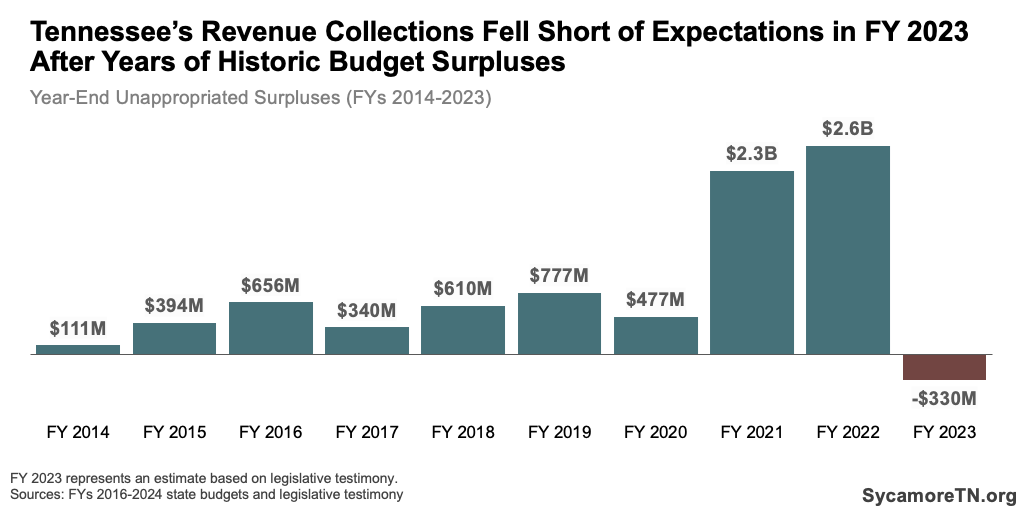
8. If rejected, much of Tennessee’s federal education funding would probably go to other states.
The ED funding formulas would likely redirect any rejected money to other states. All federal dollars for ED-funded programs are distributed to states based on a formula. If Tennessee rejected some or all of the almost $700 million it receives from these programs, those funds would not result in federal taxpayer savings unless Congress reduced its funding amounts by the same amount. While possible, it seems more likely that those funds would instead be redistributed to other states.
9. Federal requirements create administrative burdens that may or may not still exist if Tennessee rejected federal dollars.
Rejecting federal dollars could eliminate some administrative costs associated with fulfilling the cascade of reporting requirements for the state and local school districts. Certainly, state officials would likely no longer have to fulfill most or all of those requirements. The difference in administrative burden for local school districts, however, is less clear. That would depend on how rejecting federal dollars changes what the state requires of them. For example, state laws already require numerous plans and reports from districts. (129) (130) (131) (132) (133) (134) (135) (136) (137) The state would likely also replace some federal requirements with its own, which would come with continued reporting and oversight for districts.
10. Many federal requirements could still apply to Tennessee schools even if the state rejected federal K-12 dollars — creating questions that would likely be resolved in court.
Because of its broad application, the requirements tethered to federal financial assistance could still apply depending on the scope of the state’s rejection of any federal dollars. For example, in FY 2019, 72 Tennessee school districts received $60 million directly from the federal government (i.e., not through the state). (138) In addition to these sums, there may be other, less obvious ways that schools receive or benefit from federal assistance (e.g., TennCare reimbursement for certain services provided in school, Department of Defense funding for Jr. ROTC) that could continue to trigger FFA-associated mandates.
Some requirements and protections for students with disabilities and English learners would also remain in effect, but what that would functionally mean for schools is not clear. The 14th Amendment, the Equal Educational Opportunities Act, and the Civil Rights Act of 1964, for example, together require that schools ensure students with limited English proficiency can participate fully. (139) The Americans with Disabilities Act (ADA) also provides broad protections to individuals with disabilities that are not tied to receiving federal funds. While these laws guarantee access to certain services, there are outstanding questions about how these guarantees would affect school obligations without the more specific requirements tied to federal funding. (140) (119)
Tennessee schools would also continue to have obligations under the U.S. Constitution. As discussed above — through the 14th Amendment — states must still provide equal protection of the laws and due process. This has, for example, translated to court-ordered obligations outside of FFA that affect how schools serve and treat students from protected classes. (141) (142) (72) (73) (74) (75) (48) (143)
Questions about what requirements apply when and how in Tennessee would likely be worked out in court. Even with federal requirements clearly in place, the contours of what schools must do and provide and under what laws are often resolved through the court system. See the following citations for examples from Tennessee: (144) (145) (146) (147) (148) (149) (150) (151) (152) (153) (154) (155) (156). If the rules that come with federal dollars no longer apply, Tennessee and its school systems would almost certainly face additional lawsuits to clarify what other requirements apply and when.
11. It is unclear if Tennessee would still get federal education aid to weather recessions and how quickly the state could reverse course if policymakers changed their minds.
If Tennessee rejected federal K-12 dollars, it’s not clear if the state could access education funds during recessions, when supplemental dollars are often made available. During and after the Great Recession, for example, TDOE’s federal revenues grew to $1.5 billion and 30% of the department’s budget (Figure 8). This was a critical resource for plugging holes in the state budget during and after the Great Recession. These amounts were even greater during and after the COVID-19 pandemic (Figures 2 and 8).
There are also questions about how quickly the state could re-access federal dollars after rejecting them should policymakers change their mind. For example, how long would the federal government give Tennessee to come back into compliance with its requirements before dispersing funds? Could Tennessee still meet fiscal maintenance of effort and “supplement, not supplant” requirements if it withdrew any state funding it had previous used to replace the rejected federal dollars?
Figure 8
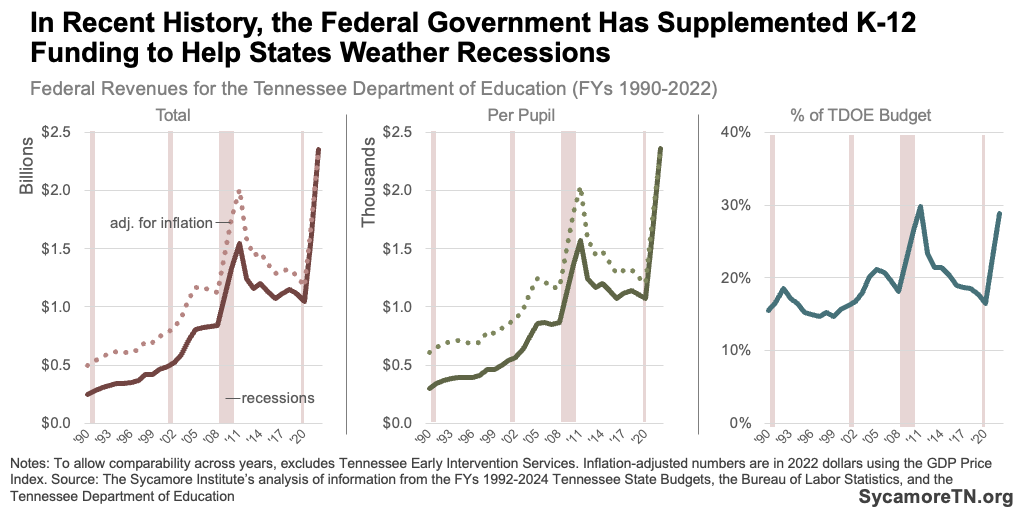
Parting Words
Tennessee policymakers are examining the state’s use of federal school funding, the associated requirements, and what it could look like to reject some or all of that money. These are largely uncharted waters. The dollars are not insignificant, and the stakes— ensuring an adequately funded public education system that meets students’ diverse needs — are high. Many of the questions that remain unanswered would likely not be resolved without litigation. Policymakers will want to carefully consider all angles and weigh the many trade-offs as they explore potential paths forward.
[1] Unless otherwise noted, this brief primarily references pre-pandemic funding allocations and distributions to reflect what Tennessee typically receives. FYs 2020-2023 funding levels — including the $1.8 billion estimated for FY 2024 in state budget documents — include temporary federal funding increases associated with the COVID-19 pandemic. At times, this brief provides information for these years for context.
[2] An estimate based on the following information: The FY 2024 budget allocated about $2.6 billion in expected recurring revenues for one-time purposes — leaving these revenues unallocated for FY 2025. Revenues fell about $330 million short of FY 2023 expectations. (128) Another $18 million in recurring revenues were appropriated during the August 2023 special session. (161)
References
Click to Open/Close
- Parker, Emily. Constitutional Obligations for Public Education: 50-State Review. Education Commission of the States. March 2016. https://files.eric.ed.gov/fulltext/ED564952.pdf
- U.S. Department of Education (ED). Table 235.20. Revenues for Public Elementary and Secondary Schools, by Source of Funds and State or Jurisdiction: 2018-19. 2021 National Digest of Education Statistics. September 2021. https://nces.ed.gov/programs/digest/d21/tables/dt21_235.20.asp
- Hornbeck, Dustin. Federal Role in Education Has a Long History. The Conversation. April 26, 2017. https://theconversation.com/federal-role-in-education-has-a-long-history-74807
- Kantor, Harvey and Lowe, Robert. Class, Race, and the Emergence of Federal Education Policy: From the New Deal to the Great Society. Educational Researcher. April 1995. https://doi.org/10.3102/0013189X024003004
- Pelsue, Brendan. When it Comes to Education, the Federal Government is in Charge of … Um, What? Harvard Ed., Harvard Graduate School of Education. August 29, 2017. https://www.gse.harvard.edu/ideas/ed-magazine/17/08/when-it-comes-education-federal-government-charge-um-what
- ESEA Network. About ESEA. https://www.eseanetwork.org/about/esea
- Klein, Alyson. ESEA’s 50-Year Legacy a Blend of Idealism, Policy Tensions. Education Week. March 31, 2015. https://www.edweek.org/policy-politics/eseas-50-year-legacy-a-blend-of-idealism-policy-tensions/2015/03
- Killion, Victoria L. Funding Conditions: Constitutional Limits on Congress’s Spending Power. Congressional Research Service. July 1, 2021. https://crsreports.congress.gov/product/pdf/R/R46827
- Tennessee Department of Education. Tennessee Federal Education Funding Report: Grants and Requirements. Prepared by request for Tennessee House of Representatives Spaker Cameron Sexton. February 2023. Provided by the Tennessee Department of Education to the Sycamore Institute on October 12, 2023
- U.S. Department of Education (ED). State Funding History Tables by State: FY 2019. January 13, 2021. Accessed from https://www2.ed.gov/about/overview/budget/history/index.html
- —. State Tables by State: FYs 2022, 2023, and 2024. October 2, 2023. https://www2.ed.gov/about/overview/budget/statetables/index.html
- U.S. Department of Agriculture (USDA). National School Lunch Program: Cash Payments (FYs 2018-2022). September 8, 2023. https://fns-prod.azureedge.us/sites/default/files/resource-files/06slcash-9.pdf
- —. School Breakfast Program: Cash Payments (FYs 2018-2022). September 8, 2023. https://fns-prod.azureedge.us/sites/default/files/resource-files/10sbcash-9.pdf
- —. Summer Food Service Program: Cash Payments (FYs 2018-2022). September 8, 2023. https://fns-prod.azureedge.us/sites/default/files/resource-files/02sfcash-9.pdf
- USASpending.gov. Total Obligations for FYs 2019 and 2022 (CFDAs 10.560, 10.582, 10.645). Obtained from https://www.usaspending.gov/.
- U.S. Department of Agriculture (USDA). FY 2019 National School Lunch Program Equipment Assistance Funds: State Allocations. https://fns-prod.azureedge.us/sites/default/files/SP15-2019a1_1.pdf
- —. Updated FY 2022 National School Lunch Program Equipment Assistance Funds: State Allocations. https://fns-prod.azureedge.us/sites/default/files/resource-files/sp01-2023-attachment1-state-allocations.pdf
- Clifford Billings, Kara. School Meals and Other Child Nutrition Programs: Background and Funding. Congressional Research Service. May 23, 2022. https://crsreports.congress.gov/product/pdf/R/R46234
- U.S. Department of Agriculture (USDA). FNS 101 Fact Sheets. Food and Nutrition Service. https://fns-prod.azureedge.us/sites/default/files/resource-files/FNS-101-Factsheets-All.pdf
- —. National School Lunch: Meals Served. State Level Tables: FY 2018-2022. Accessed from https://www.fns.usda.gov/pd/child-nutrition-tables.
- —. National School Lunch Program: Participation. State Level Tables: FY 2018-2022. Accessed from https://www.fns.usda.gov/pd/child-nutrition-tables.
- —. School Breakfast: Meals Servied. State Level Tables: FY 2018-2022. Accessed from https://www.fns.usda.gov/pd/child-nutrition-tables.
- —. School Breakfast: Participation. State Level Tables: FY 2018-2022. Accessed from https://www.fns.usda.gov/pd/child-nutrition-tables.
- —. Summer Food Service: Meals Served. State Level Tables: FY 2018-2022. Accessed from https://www.fns.usda.gov/pd/child-nutrition-tables.
- —. Summer Food Service: Participation. State Level Tables: FY 2018-2022. Accessed from https://www.fns.usda.gov/pd/child-nutrition-tables.
- —. 88 FR 43266 – National School Lunch, Special Milk, and School Breakfast Programs, National Average Payments/Maximum Reimbursement Rates. Federal Register.July 7, 2023. https://www.federalregister.gov/d/2023-14313/page-43269
- —. 88 FR 8397 – Child Nutrition Programs: Income Eligibility Guidelines . Federal Register. February 9, 2023. https://www.federalregister.gov/documents/2023/02/09/2023-02739/child-nutrition-programs-income-eligibility-guidelines
- —. Eligibility Manual for School Meals: Determining and Verifying Eligibility. July 18, 2017. https://fns-prod.azureedge.us/sites/default/files/cn/SP36_CACFP15_SFSP11-2017a1.pdf
- —. 7 CFR Part 210.14(e) – Pricing Paid Lunches. Code of Federal Regulations. September 5, 2023. https://www.ecfr.gov/current/title-7/subtitle-B/chapter-II/subchapter-A/part-210#p-210.14(e)
- —. Memo SP 11-2023: Paid Lunch Equity – Guidance for School Year 2023-2024. April 5, 2023. https://fns-prod.azureedge.us/sites/default/files/resource-files/SP11-2023os.pdf
- —. 7 CFR Part 210.10 – Meal Requirements for Lunchs and Requirements for Afterschool Snacks.Code of Federal Regulations. September 5, 2023. https://www.ecfr.gov/current/title-7/subtitle-B/chapter-II/subchapter-A/part-210/subpart-C/section-210.10
- —. 7 CFR Part 210.8 – Claims for Reimbursement. Code of Federal Regulations. September 5, 2023. https://www.ecfr.gov/current/title-7/subtitle-B/chapter-II/subchapter-A/part-210#210.8
- —. 7 CFR Part 245 – Determining Eligibility for Free and Reduced Price Meals and Free Milk in Schools. Code of Federal Regulations. September 5, 2023. https://www.ecfr.gov/current/title-7/subtitle-B/chapter-II/subchapter-A/part-245
- Tennessee Department of Education. Title I, Part A – Improving Basic Programs Operated by Local Educational Agencies. September 2018. https://www.tn.gov/content/dam/tn/education/asd/office-of-federal-programs/helpful-resources/Title%20I,%20Part%20A-Improving%20Basic%20Education.pdf
- U.S. Government. Title I of the Every Student Succeeds Act (ESSA). https://oese.ed.gov/offices/office-of-formula-grants/school-support-and-accountability/essa-legislation-table-contents/title-i-part-a/
- Skinner, Rebecca R. The Elementary and Secondary Education Act (ESEA), as Amended by the Every Student Succeeds Act (ESSA): A Primer. Congressional Research Service. April 20, 2022. https://crsreports.congress.gov/product/pdf/R/R45977
- U.S. Department of Education (ED). Presentation: Title I Allocation Formulas. February 2018. https://www2.ed.gov/about/offices/list/oese/oss/technicalassistance/titleiallocationformulastitleiconfppt22018.pdf
- Gordon, Nora and Reber, Sarah. Title I of ESEA: How the Formulas Work. All4Ed. January 24, 2023. https://all4ed.org/publication/title-i-of-esea-how-the-formulas-work/
- U.S. Department of Education (ED). Total Enrollment (Excluding Adult Education) for School Year 2018-19. National Center for Education Statistics. https://nces.ed.gov/ccd/elsi/tableGenerator.aspx?savedTableID=648305
- U.S. Census Bureau. S1701: Poverty Status in the Past 12 Months. American Community Survey 1-Year Estimates for 2019. https://data.census.gov/table/ACSST1Y2019.S1701?q=poverty+status&g=040XX00US01,02,04,05,06,08,09,10,11,12,13,15,16,17,18,19,20,21,22,23,24,25,26,27,28,29,30,31,32,33,34,35,36,37,38,39,40,41,42,44,45,46,47,48,49,50,51,53,54,55,56&moe=false
- U.S. Government. Title I-A, Section 1111 of the Every Student Succeeds Act (ESSA). https://oese.ed.gov/offices/office-of-formula-grants/school-support-and-accountability/essa-legislation-table-contents/title-i-part-a/#sec-1111
- —. Title I-F, Section 1604 of the Every Student Succeeds Act (ESSA). https://oese.ed.gov/offices/office-of-formula-grants/school-support-and-accountability/essa-legislation-table-contents/title-i-part-a/
- —. Title VIII-F of the Every Student Succeeds Act (ESSA). https://oese.ed.gov/offices/office-of-formula-grants/school-support-and-accountability/essa-legislation-table-contents/title-viii-general-provisions/
- U.S. Department of Education (ED). Every Student Succeeds Act – Assessments under Title I, Part A & Title I, Part B: Summary of Final Regulations. December 2016. https://www2.ed.gov/policy/elsec/leg/essa/essaassessmentfactsheet1207.pdf
- U.S. Government. Title I-A, Section 1118 of the Every Student Succeeds Act (ESSA). https://oese.ed.gov/offices/office-of-formula-grants/school-support-and-accountability/essa-legislation-table-contents/title-i-part-a/#sec1118
- Skinner, Rebecca. Fiscal Accountability Requirements That Apply to Title I-A of the Elementary and Secondary Education Act (ESEA). Congressional Research Service. May 16, 2016. https://crsreports.congress.gov/product/pdf/IF/IF10405
- U.S. Department of Education (ED). Consolidated State Performance Reports.https://oese.ed.gov/offices/office-of-administration/about-us/consolidated-state-performance-reports/
- Congressional Research Service (CRS). The Individuals with Disabilities Education Act (IDEA) Funding: A Primer. August 19, 2019. https://crsreports.congress.gov/product/pdf/R/R44624
- —. The Individuals with Disabilities Education Act (IDEA), Part B: Key Statutory and Regulatory Provisions. August 29, 2019. https://crsreports.congress.gov/product/pdf/R/R41833
- U.S. Department of Education (ED). Table 204.70. Number and Percentage of Children Served Under Individuals with Disabilities Education Act (IDEA), Part B, by Age Group and State or Jurisdiction: Selected School Years, 1990-91 through 2021-22. National Digest of Education Statistics. February 2023. https://nces.ed.gov/programs/digest/d22/tables/dt22_204.70.asp
- U.S. Government. Part B, Section 1412 of the Individuals with Disabilities Education Act (IDEA). https://sites.ed.gov/idea/statute-chapter-33/subchapter-ii/1412
- U.S. Supreme Court. Endrew F. v. Douglas County School District, No. 15–827. March 2017. https://www.supremecourt.gov/opinions/16pdf/15-827_0pm1.pdf
- Congressional Research Service (CRS). The Individuals with Disabilities Education Act (IDEA): Supreme Court Decisions. January 11, 2010. https://www.everycrsreport.com/files/20100111_RL33444_5d72631d987855ed195083d540e670ce355dda86.pdf
- U.S. Government. Part A, Section 1401 of the Individuals with Disabilities Education Act (IDEA). https://sites.ed.gov/idea/statute-chapter-33/subchapter-i/1401
- —. Part B, Section 1414 of the Individuals with Disabilities Education Act (IDEA). https://sites.ed.gov/idea/statute-chapter-33/subchapter-ii/1414
- —. Part B, Section 1415 of the Individuals with Disabilities Education Act (IDEA). https://sites.ed.gov/idea/statute-chapter-33/subchapter-ii/1415
- Back, Christine J. and Cole, Jared P. Federal Financial Assistance and Civil Rights Requirements. Congressional Research Service. May 18, 2022. https://crsreports.congress.gov/product/pdf/R/R47109
- Smole, David P. A Summary of Federal Education Laws Administered by the U.S. Department of Education. Congressional Research Service. November 28, 2022. https://crsreports.congress.gov/product/pdf/IF/IF10551
- Cole, Jared P. Race Discrimination at School: Title VI and the Department of Education’s Office for Civil Rights. Congressional Research Service. July 21, 2023. https://crsreports.congress.gov/product/pdf/IF/IF12455
- Back, Christine J. The Civil Rights Act of 1964: Eleven Titles at a Glance. Congressional Research Service. December 14, 2020. https://crsreports.congress.gov/product/pdf/IF/IF11705
- U.S. Department of Education (ED). Know Your Rights. Office for Civil Rights. January 10, 2020. https://www2.ed.gov/about/offices/list/ocr/know.html
- Tennessee Department of Education. Civil Rights Title VI. https://www.tn.gov/education/legal-services/civil-rights/civil-rights-title-vi.html
- —. Civil Rights Title IX. https://www.tn.gov/education/legal-services/civil-rights/civil-rights-title-ix.html
- Administrative Office of the U.S. Courts. The 14th Amendment and the Evolution of Title IX. https://www.uscourts.gov/educational-resources/educational-activities/14th-amendment-and-evolution-title-ix
- Dragoo, Kyrie E. and Cole, Jared P. Law Affecting Students with Disabilities: Preschool Through Postsecondary Education. Congressional Research Service. March 13, 2019. https://crsreports.congress.gov/product/pdf/R/R45595
- U.S. Department of Education (ED). Frequently Asked Questions About Section 504 and the Education of Children with Disabilities. Office for Civil Rights. July 18, 2023. https://www2.ed.gov/about/offices/list/ocr/504faq.html
- —. Disability Discrimination: Overview of the Laws. Office of Civil Rights. February 11, 2022. https://www2.ed.gov/policy/rights/guid/ocr/disabilityoverview.html
- U.S. Department of Justice (DOJ). Types Of Educational Opportunities Discrimination. Civil Rights Division. March 25, 2021. https://www.justice.gov/crt/types-educational-opportunities-discrimination
- U.S. Department of Education (ED). Family Educational Rights and Privacy Act (FERPA).
- —. Boy Scouts of America Equal Access Act. Office of Civil Rights. February 11, 2022. https://www2.ed.gov/policy/rights/guid/ocr/boyscouts.html
- U.S. Government. U.S. Code 2014, Title 35: Patriotic and National Observances, Ceremonies, and Organizations. https://www.govinfo.gov/content/pkg/USCODE-2014-title36/html/USCODE-2014-title36.htm
- U.S. Department of Justice (DOJ). Justice Department Secures Agreement to Remedy Racial Harassment of Black and Multi-Racial Students in Kentucky School District. June 12, 2023. https://www.justice.gov/opa/pr/justice-department-secures-agreement-remedy-racial-harassment-black-and-multi-racial-students
- —. Case Summaries: Child Evangelism Fellowship v. Lenz . Civil Right Division. Accessible via https://www.justice.gov/crt/case-summaries.
- —. Case Summaries: Communities for Equity v. Michigan High School Athletic Association. Civil Right Division. Accessible via https://www.justice.gov/crt/case-summaries.
- —. Case Summaries: Pedersen & United States v. South Dakota High School Activities Association. Civil Right Division. Accessible via https://www.justice.gov/crt/case-summaries.
- Congressional Research Service (CRS). Educational Assessment and the Elementary and Secondary Education Act. December 19, 2017. https://crsreports.congress.gov/product/pdf/R/R45049
- U.S. Department of Education (ED). Tennessee Consolidated Performance Review Report: #2 of 2 (FY 2021). November 30, 2021. https://oese.ed.gov/files/2021/11/TDOE-Performance-Monitoring-Review-Report-2.pdf
- Lane, James F. Letter to Commissioner of Education Penny Schwinn. U.S. Department of Education. September 27, 2022. https://oese.ed.gov/files/2023/02/tn-fy22-condition-ltr-2022.pdf
- —. Letter to Interim Commissioner of Education Sam Pearcy. U.S. Department of Education (ED). June 22, 2023. https://oese.ed.gov/files/2023/06/TDOErevisedwaiverresponseletter.pdf
- Tennessee Department of Education. Tennessee’s ESSA State Plan: Proposed Revisions Summary. https://www.tn.gov/content/dam/tn/education/documents/Proposed_Revisions_Summary_one_pager.pdf
- —. Redline Version: Tennessee’s ESSA State Plan (updated May 1, 2023). https://www.tn.gov/content/dam/tn/education/documents/TN_ESSA_State_Plan_Redline.pdf
- Administration of Joseph R. Biden, Jr.,. Executive Order 14021—Guaranteeing an Educational Environment Free From Discrimination on the Basis of Sex, Including Sexual Orientation or Gender Identity. March 8, 2021. https://www.govinfo.gov/content/pkg/DCPD-202100214/pdf/DCPD-202100214.pdf
- U.S. Department of Education (ED). Fact Sheet: U.S. Department of Education’s 2022 Proposed Amendments to its Title IX Regulations. July 2022. https://www2.ed.gov/about/offices/list/ocr/docs/t9nprm-factsheet.pdf
- —. Notice of Proposed Rulemaking: 24 CFR Part 106 – Nondiscrimination on the Basis of Sex in Education Programs or Activities Receiving Federal Financial Assistance. Federal Register. July 12, 2022. https://www.govinfo.gov/content/pkg/FR-2022-07-12/pdf/2022-13734.pdf
- —. Fact Sheet: U.S. Department of Education’s Proposed Change to its Title IX Regulations on Students’ Eligibility for Athletic Teams. April 6, 2023. https://www2.ed.gov/about/offices/list/ocr/docs/t9-ath-nprm-factsheet.pdf
- —. Notice of Proposed Rulemaking: 34 CFR Part 106 – Nondiscrimination on the Basis of Sex in Education Programs or Activities Receiving Federal Financial Assistance: Sex-Related Eligibility Criteria for Male and Female Athletic Teams. Federal Register. April 13, 2023. https://www.govinfo.gov/content/pkg/FR-2023-04-13/pdf/2023-07601.pdf
- —. A Timing Update on Title IX Rulemaking. May 26, 2023. https://blog.ed.gov/2023/05/a-timing-update-on-title-ix-rulemaking/
- U.S. District Court for the Eastern District of Tennessee. State of Tennessee v. U.S. Department of Education (Case No. 3:21-cv-00308): Complaint for Declaratory and Injunctive Relief. August 30, 2021. https://www.tn.gov/content/dam/tn/attorneygeneral/documents/pr/2021/pr21-31-complaint.pdf
- —. State of Tennessee v. USDA (Case No. 3:33-cv-00257): Complaint for Declaratory and Injunctive Relief. July 26, 2022. https://content.govdelivery.com/attachments/INAG/2022/07/26/file_attachments/2228235/Lawsuit%20against%20USDA.pdf
- Tennessee Attorney General & Reporter. AG Slatery Leads 22 States Against Biden Administration for Threatening to Withhold Nutrition Assistance for Schools; Programs that Don’t Adhere to ‘Gender Identity’, ‘Sexual Orientation’ Policy. July 26, 2022. https://www.tn.gov/attorneygeneral/news/2022/7/26/pr22-24.html
- —. TN AG Skrmetti Urges President Biden’s Administration to Uphold Title IX and Protect Privacy, Safety and Equality for Females. May 16, 2023. https://www.tn.gov/attorneygeneral/news/2023/5/16/ma23-27.html
- —. TN Attorney General Jonathan Skrmetti Joins Amicus Brief Filed with U.S. Supreme Court in Support of Fairness in Women’s Sports. March 16, 2023. https://www.tn.gov/attorneygeneral/news/2023/3/16/pr23-11.html
- —. TN AG Skrmetti Joins Multistate Coalition in Support of Florida Law Preserving Girls’ Sports Teams for Biological Females. February 15, 2023. https://www.tn.gov/attorneygeneral/news/2023/2/15/pr23-08.html
- —. TN Attorney General’s Office Responds to Federal Government Appeal of Preliminary Injunction of Title IX Overreach. January 26, 2023. https://www.tn.gov/attorneygeneral/news/2023/1/26/pr23-05.html
- —. AG Skrmetti Leads State AG Response to U.S. Department of Education’s Proposed Regulations; Redefinition of “Sex”. September 12, 2022. https://www.tn.gov/attorneygeneral/news/2022/9/12/pr22-34.html
- —. District Court Rules: Federal Government Cannot Force Tennessee, 19 Other States to Allow Biological Males to Compete on Girls’ Sports Teams, Use Girls’ Showers/Locker Rooms. July 17, 2022. https://www.tn.gov/attorneygeneral/news/2022/7/17/pr22-23.html
- —. AG Slatery Disputes Federal Directive to Withhold Nutrition Assistance for Schools, Programs that Don’t Adhere to New ‘Gender Identity’, ‘Sexual Orientation’ Policy . June 14, 2022. https://www.tn.gov/attorneygeneral/news/2022/6/14/pr22-16.html
- —. AG Slatery Sues Biden Administration to Stop Enforcement of Guidance that Threatens Women’s Sports and Student and Employee Privacy. August 30, 2021. https://www.tn.gov/attorneygeneral/news/2021/8/30/pr21-31.html
- State of Tennessee. Tenn. Code Ann. § 49-6-310.
- —. Public Chapter No. 40 (2021). March 26, 2021. https://publications.tnsosfiles.com/acts/112/pub/pc0040.pdf
- —. Public Chapter No. 909 (2022). April 22, 2022. https://publications.tnsosfiles.com/acts/112/pub/pc0909.pdf
- Fiscal Review Committee Staff. Fiscal Memorandum: HB 3 – SB 228. Tennessee General Assembly. February 5, 2021. https://www.capitol.tn.gov/Bills/112/Fiscal/FM0017.pdf
- —. Fiscal Note: HB 1895 – SB 1861. Tennessee General Assembly. February 19, 2022. https://www.capitol.tn.gov/Bills/112/Fiscal/HB1895.pdf
- —. Fiscal Memorandum: HB 239 – SB 1440. Tennessee General Assembly. February 28, 2023. https://www.capitol.tn.gov/Bills/113/Fiscal/FM0381.pdf
- State of Tennessee. Public Chapter No. 1440 (2023). May 17, 2023. https://publications.tnsosfiles.com/acts/113/pub/pc0486.pdf
- Tennessee Department of Education. Overview of Testing in Tennessee. https://www.tn.gov/education/districts/lea-operations/assessment/testing-overview.html#:~:text=Tennessee%20Comprehensive%20Assessment%20Program%20(TCAP)%20has%20been%20the%20state’s%20testing,for%20students%20with%20special%20needs
- SCORE. Meaningful Measures of Student Learning: Improving Assessment in Tennessee. March 2015. https://tnscore.org/wp-content/uploads/2015/03/Meaningful-Measures-of-Student-Learning_PolicyReport2015.pdf
- State of Tennessee. Tenn. Code Ann. § 49-1-228.
- —. Tenn. Code Ann. § 49-1-606.
- —. Chapter 0520-01-06: Child Nutrition Programs. Rules of State Board of Education. January 2017. https://publications.tnsosfiles.com/rules/0520/0520-01/0520-01-06.20170105.pdf
- —. Tenn. Code Ann. § 49-3-313.
- —. Chapter 0520-01-21: Civil Rights Compliance. Rules of the State Board of Education. October 2022. https://publications.tnsosfiles.com/rules/0520/0520-01/0520-01-21.20221017.pdf
- —. Chapter 0520-01-09: Special Education Programs and Services. Rules of the State Board of Education. April 2023. https://publications.tnsosfiles.com/rules/0520/0520-01/0520-01-09.20230406.pdf
- —. Tenn. Code Ann. § 49 Chapter 10.
- Tennessee Department of Education. Office of Civil Rights: Case Investigation and Resolution Manual. June 2023. https://www.tn.gov/content/dam/tn/education/legal/Civil_Rights_Case_Resolution_Manual.pdf
- U.S. Department of Education (ED). How to File a Discrimination Complain with the Office for Civil Rights. Office for Civil Rights. March 8, 2023. https://www2.ed.gov/about/offices/list/ocr/docs/howto.html
- —. Office for Civil Rights Recent Resolution Search. Office for Civil Rights. Tennessee cases available via https://ocrcas.ed.gov/ocr-search?f%5B0%5D=it%3AElementary%20and%20Secondary&f%5B1%5D=state_fullname%3A685.
- —. Pending Cases Currently Under Investigation at Elementary-Secondary and Post-Secondary Schools as of October 2, 2023 7:30am Search. Office for Civil Rights. Available from https://www2.ed.gov/about/offices/list/ocr/docs/investigations/open-investigations/index.html.
- Heigl, Lillie and Stadler, Zahava. Refusing Federal Education Dollars Jeopardizes Students with Disabilities . New America. https://www.newamerica.org/education-policy/edcentral/refusing-federal-education-dollars-jeopardizes-students-with-disabilities/
- Brown, Melissa. ‘Just Listen’: Why Disability Advocates Are Warily Eyeing Federal Education Funding Debate. The Tennessean. October 19, 2023. https://www.tennessean.com/story/news/politics/2023/10/19/tennessee-education-disability-advocates-parents-warily-eye-federal-funding-debate/71203021007/
- Schelzig, Erik. Speakers Announce Task Force to Look Into Rejecting Federal Education Money. September 25, 2023. https://onthehill.tnjournal.net/speakers-announce-task-force-to-look-into-rejecting-federal-education-money/
- Jones, Vivian. Legislative Panel to Explore Rejecting Tennessee’s Share of Federal Education Money. The Tennessean. September 25, 2023. https://www.tennessean.com/story/news/politics/2023/09/25/tennessee-legislative-panel-study-rejecting-federal-education-funding/70963525007/
- Alliance for Excellent Education. Every Student Succeeds Act: Accountability Provisions. January 2016. https://all4ed.org/wp-content/uploads/2015/12/ESSAAccountabilityChart2.pdf
- Understood. The Difference Between the Every Student Succeeds Act and No Child Left Behind. https://www.understood.org/en/articles/the-difference-between-the-every-student-succeeds-act-and-no-child-left-behind
- Tennessee Department of Education. Every Student Succeeds Act: Building on Success in Tennessee – Status Report. October 2016. https://www.tn.gov/content/dam/tn/stateboardofeducation/documents/meetingfiles2/10-13-16_2_30_ESSA_Update.pdf
- National Council on Disability. Broken Promises: The Underfunding of IDEA. February 7, 2018. https://ncd.gov/sites/default/files/NCD_BrokenPromises_508.pdf
- State of Tennessee. State Budget Documents. Available from https://www.tn.gov/finance/fa/fa-budget-information/fa-budget-archive.html.
- House Finance Ways and Means Commitee. Testimony of Tennessee Department of Finance and Administration. Tennessee General Assembly. August 24, 2023. https://tnga.granicus.com/player/clip/28857?view_id=726&redirect=true&h=b284c0ba4d7f656e36e231dcf18be5
- State of Tennessee. Tenn. Code Ann. § 49-10-11.
- —. Tenn. Code Ann. § 49-3-316.
- —. Tenn. Code Ann. § 49-10-1304.
- —. Tenn. Code Ann. § 49-6-4108.
- —. Tenn. Code Ann. § 49-1-613.
- —. Tenn. Code Ann. § 49-6-804.
- —. Tenn. Code Ann. § 49-6-3009.
- —. Tenn. Code Ann. § 49-2-138.
- —. Tenn. Code Ann. § 49-6-1509.
- Tennessee Department of Education. 2019 Annual Statistical Report: Table 15. Available from https://www.tn.gov/education/districts/federal-programs-and-oversight/data/department-reports/2019-annual-statistical-report.html.
- U.S. Departments of Justice (DOJ) and Education (ED). Dear Colleague Letter: English Learner Students and Limited English Proficient Patents. January 2015. https://www2.ed.gov/about/offices/list/ocr/letters/colleague-el-201501.pdf
- Congressional Research Service (CRS). Laws Affecting Students with Disabilities: Preschool Through Postsecondary Education. March 13, 2019. https://crsreports.congress.gov/product/pdf/R/R45595
- Civil Rights Litigation Clearinghouse. Case: Mills v. Board of Education of the District of Columbia . University of Michigan Law School. https://clearinghouse.net/case/11084/
- —. Case: PARC v. Commonwealth of Pennsylvania . University of Michigan Law School. https://clearinghouse.net/case/11082/
- Administrative Office of the U.S. Courts. Access to Education – Rule of Law. https://www.uscourts.gov/educational-resources/educational-activities/access-education-rule-law
- U.S. Department of Justice (DOJ). Justice Department Secures Agreement in Tennessee School Desegregation Case. October 11, 2023. https://www.justice.gov/opa/pr/justice-department-secures-agreement-tennessee-school-desegregation-case
- United States District Court – Eastern District of Tennessee at Knoxville. Bannister et al v. Knox County Board of Education et al, No. 3:2018cv00188 – Document 49 (E.D. Tenn. 2021). 2021. https://law.justia.com/cases/federal/district-courts/tennessee/tnedce/3:2018cv00188/85644/49/
- —. A.W. et al v. Tennessee Department of Education et al, No. 3:2020cv00076 – Document 117 (E.D. Tenn. 2022). 2022. https://law.justia.com/cases/federal/district-courts/tennessee/tnedce/3:2020cv00076/93405/117/
- —. Rachel Vandergriff, et. al. v. Knox County Board of Education, et. al., No. 3:2020cv00005 – Document 23 (E.D. Tenn. 2020). 2020. https://law.justia.com/cases/federal/district-courts/tennessee/tnedce/3:2020cv00005/92761/23/
- United States District Court – Eastern District of Tennessee Greeneville Division. Doe et al v. Washington County Department of Education et al, No. 2:2016cv00272 – Document 87 (E.D. Tenn. 2020). 2020. https://law.justia.com/cases/federal/district-courts/tennessee/tnedce/2:2016cv00272/79304/87/
- United States DIstrict Court – Western District of Tennessee. K.B. et al v. Memphis-Shelby County Schools, No. 2:2022cv02464 – Document 50 (W.D. Tenn. 2023). 2023. https://law.justia.com/cases/federal/district-courts/tennessee/tnwdce/2:2022cv02464/96030/50/
- United States District Court – Middle District of Tennessee Nashville Division. Torres v. Stewart County School System et al, No. 3:2021cv00910 – Document 60 (M.D. Tenn. 2023). 2023. https://law.justia.com/cases/federal/district-courts/tennessee/tnmdce/3:2021cv00910/88679/60/
- —. E.S. et al v. Clarksville Montgomery County School System et al, No. 3:2021cv00283. 2023. https://law.justia.com/cases/federal/district-courts/tennessee/tnmdce/3:2021cv00283/85763/56/
- —. J.L. et al. v. Williamson County Board of Education, No. 3:2023cv00516. 2023. https://law.justia.com/cases/federal/district-courts/tennessee/tnmdce/3:2023cv00516/94693/27/
- —. D.H. v. Williamson County Board of Education et al, No. 3:2022cv00570. 2022. https://law.justia.com/cases/federal/district-courts/tennessee/tnmdce/3:2022cv00570/91396/55/
- United States District Court – Middle District of Tennessee Northeastern Division. B.A.P. et al v. Overton County Board of Education, No. 2:2020cv00065. 2022. https://law.justia.com/cases/federal/district-courts/tennessee/tnmdce/2:2020cv00065/84198/68/
- United States District Court – Middle District of Tennessee Nashville Division. G.C.A. et al v. Williamson County Board of Education, No. 3:2020cv00741. 2022. https://law.justia.com/cases/federal/district-courts/tennessee/tnmdce/3:2020cv00741/83740/44/
- —. C.M. et al v. Rutherford County Schools, No. 3:2020cv01088. 2022. https://law.justia.com/cases/federal/district-courts/tennessee/tnmdce/3:2020cv01088/84841/55/
- Tennessee Department of Education. Annual Statistical Reports – Statistical Summaries. Available from https://www.tn.gov/education/districts/federal-programs-and-oversight/data/department-reports/2022-annual-statistical-report.html
- U.S. Bureau of Economic Analysis (BEA). Gross Domestic Product: Chain-type Price Index [GDPCTPI]. Retrieved from FRED, Federal Reserve Bank of St. Louis. https://fred.stlouisfed.org/series/GDPCTPI
















